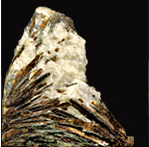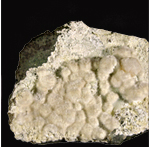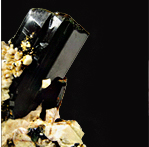Classification of Minerals(8. Silicates-2)
(3) Cyclosilicates
Cyclosilicates contain rings of linked SiO4 tetrahedra and each SiO4 group shares two oxygens with adjoining tetrahedra on either side to form the general formula n·SiO32-. In general, they have relatively high hardness and many minerals in this subclass are used as gems.
Cyclosilicates include axinite, beryl, cordierite, tourmaline and benitoite. Axinite is used as a minor gem and named after a Greek word meaning axe. Beryl has many gem varieties: emerald deep green, aquamarine blue green, heliodor greenish yellow, morganite pink, goshenite colorless and golden beryl yellow. Cordierite is typically blue and clear blue varieties are used as gemstones. Iolite, a variety of cordierite, shows violet color. Tourmaline is piezoelectric and has many varieties. Iron-bearing black schorl is the most common tourmaline. The other common ones are elbaite, dravite, and uvite. Clear and good-colored tourmaline is commonly used as a gem. Benitoite is also used as a gem.

Tourmaline Brazil
Tourmaline occurs commonly as black columnar crystals. Its Mohs hardness ranges from 7 to 7.5 and its specific gravity is about 3.0-3.25. It is so strongly piezoelectric that, as well as a gem, it can be used in the manufacture of pressure gauges.

BerylCheongwon, Korea
Beryl contains the rare element beryllium. Its Mohs hardness is about 7.5-8. Based on its color, beryl is subdivided into many varieties, which are used as gems.

Aquamarine Pakistan
A blue green variety of beryl is called aquamarine, which is used as a gem.

Dioptase Namibia
Dioptase is an intense emerald-green to bluish-green copper cyclosilicate mineral. It is very fragile and specimens must be handled with great care. It is not used as gems due to its fragility.
(4) Inosilicates
Inosilicates have SiO4 tetrahedra linked by sharing oxygens to form simple chains with composition SiO32-. Two simple chains may be cross-linked side by side in alternate tetrahedra to form double chains with composition of Si4O116-.
The single chain inosilicates include the pyroxene group (aegirine, augite, diopside, enstatite, hedenbergite, hypersthene, jadeite, spodumene), okenite, rhodonite, serandite and wollastonite. The double chain inosilicates include the amphibole group (actinolite, anthophyllite, cummingtonite, edenite, hornblende, riebeckite, tremolite), astrophyllite and babingtonite. The single chains and the double chains are represented by pyroxenes and amphiboles respectively. Many similarities exist in their structural, chemical and physical properties. They have almost identical unit cells except for a doubling in the b direction in the amphiboles. They have similar physical properties of cleavage, color, luster and hardness. However, amphiboles are slightly lower in specific gravity and refractive index than pyroxenes.

Astrophyllite Russia
Astrophyllite, a kind of double chain inosilicates, shows bladed or radial crystal shape. It is bronze yellow or golden yellow in color. Its luster is submetallic or pearly. It is found in cavities and fissures in unusual felsic igneous rocks. It is slightly soluble in acid, easily splittable and fragile.

Okenite India
Okenite is a silicate mineral that is usually associated with zeolites. It most commonly is found as small white ‘cotton ball’ formations within basalt geodes. Its hardness is 4.5 to 5, and its specific gravity is about 3.3. It is named after for German naturalist Lorenz Oken.

Aegirine Zomba, Malawi
Aegirine is a member of the clinopyroxene group of inosilicates. Aegirine occurs as dark green monoclinic prismatic crystals. It has glassy luster and perfect cleavage. Its Mohs hardness varies from 5 to 6 and its specific gravity is 3.2 to 3.4.